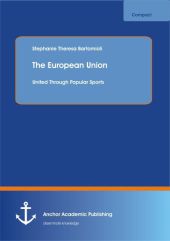 Neuerscheinungen 2015Stand: 2020-02-01 |
Schnellsuche
ISBN/Stichwort/Autor
|
Herderstraße 10
10625 Berlin
Tel.: 030 315 714 16
Fax 030 315 714 14
info@buchspektrum.de |

Stephanie Theresa Bartomioli
The European Union: United Through Popular Sports
Erstauflage. 2015. 68 S. 220 mm
Verlag/Jahr: ANCHOR ACADEMIC PUBLISHING 2015
ISBN: 3-9548935-6-8 (3954893568)
Neue ISBN: 978-3-9548935-6-0 (9783954893560)
Preis und Lieferzeit: Bitte klicken
The EUSB (European Sports Badge) is meant to target a large audience through popular sports. Modern sport and its various events have been originated in Europe during the past two centuries. Physical exercise and personal fitness are nowadays well-respected and truly popular. This study aims at responding to the question, to what extent popular sport can make a contribution to the genesis, the implementation, and the fostering of a mutually acknowledged and experienced EU-identity. A differentiation between the two main spheres of sport, professional sports and popular sports, shows that the official and documented emphasis of the EU on the professional sphere hitherto led to negligence and a misconceiving attitude towards mass sports so far.
Text Sample:
Chapter 2. The European Union and its prospective identity:
Referring to the prevailing view, it can be said that there is no stable core, no given European identity which would be perceived by Europeans. In order to specify the term of identity in this study, one has to draw a line between a European identity in general and the EU-identity in particular. To what extent are these two identities synonymous ? What aspects cause a differentiation? Bruter points out that the definition of the terms of perception of Europe is decisive. He contrasts a cultural point of view from a political one.
This information enables politicians to develop specifically tailored governance projects in order to foster the genesis of an EU-identity. The EU is predominantly experienced as a po-litical, value and economic community and as a political entity based on universal val-ues . This knowledge challenges politicians in finding an appropriate answer to the question of what kind of EU-identity should be generated what are its basic contents?
This second section aims at developing a solid blueprint of a potential EU-identity, taking into consideration that the EU is a political system sui generis and so will be its identity, viz. one cannot simply copy some national identity. Apart from that, the hereby developed EU-identity does not aim as replacing traditional national identities of EU member states.
With the extensive use of the term identity in everyday language, its scientific expression has become rather diffuse and polysemous. Identity is not predetermined possession, but it means the social process of self-definition of individuals or groups, based on a mutually accepted embodiment of values . Moreover, it is defined by inclusionary and exclusionary schemes. Yet another distinction has to be made between the subjects and the objects of identification, in other words, who for example, elites or ordinary citizens identifies with whom or what for example, gender, nation, or Europe . So, identities emerge in the very process by which individuals and social groups make sense of who they are and what they want . However, every definition has to be seen as a part of one of diverse individual theoretical approaches that should be regarded as a whole.
Although the question of political identity is not new , the jargon is newly fashionable and it is of interest to many political theorists. Due to its uniqueness, the lack of analogs of supranational structures like the EU challenges theorists of all disciplines researching collective identities. Consequently, the politics of European identity [are explored] by adopt-ing a multi-disciplinary perspective in order to give consideration to the complexity of EU-identity. The responsibility of policy-makers is humongous: In our post-modern world, we more and more exhibit multiple identities that exist in fractured and non-contiguous forms . Thence, a prospective EU-identity has to be solid, it has to be in accordance with the EU member states desires, and it has to be mutually acknowledged to be accepted.


